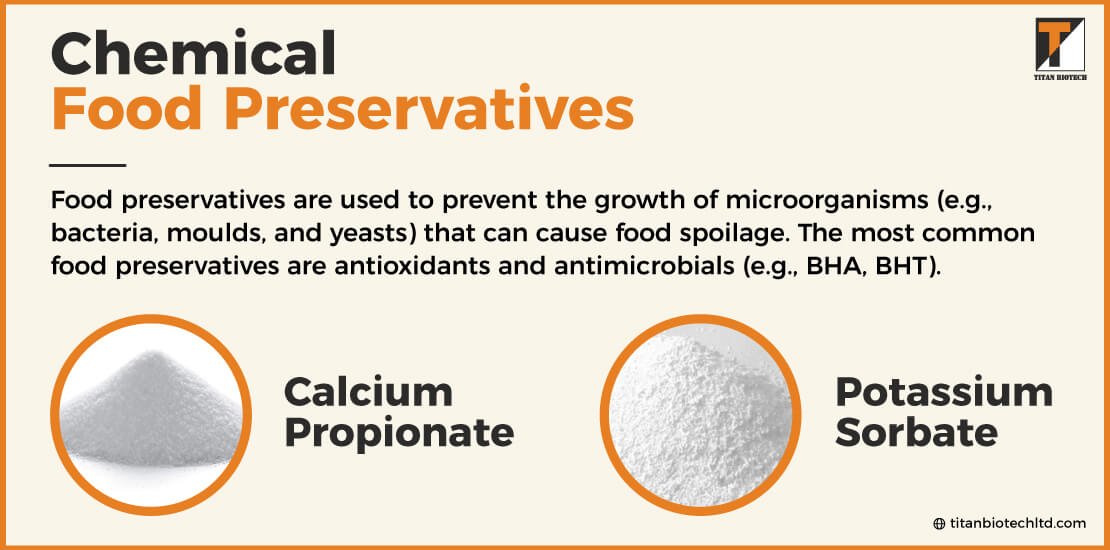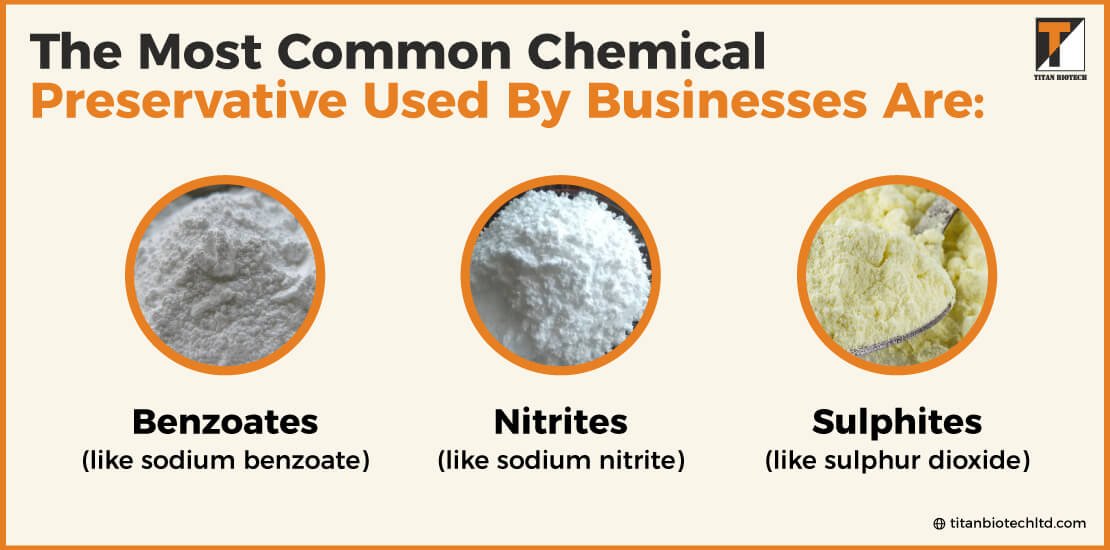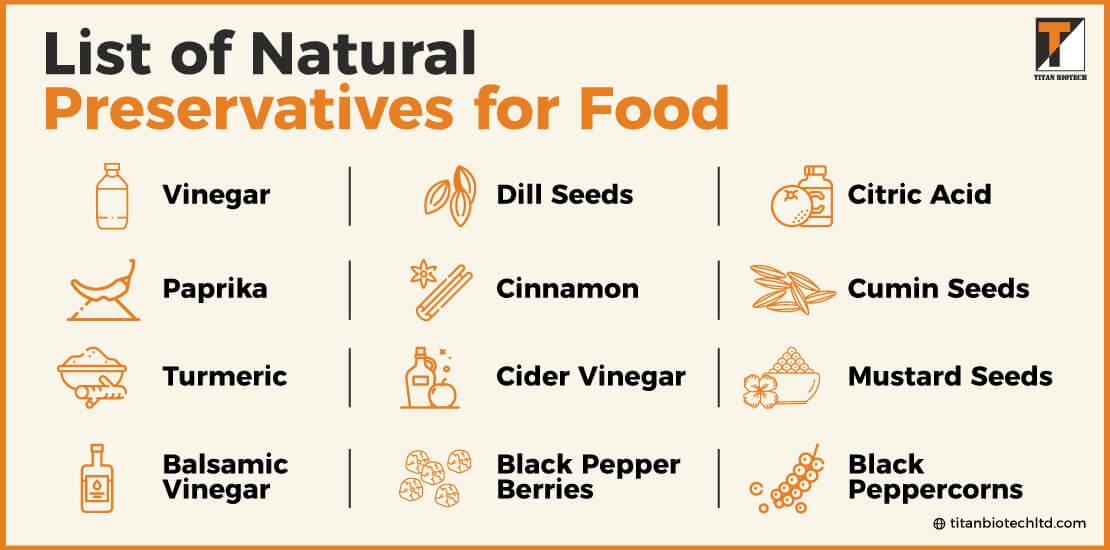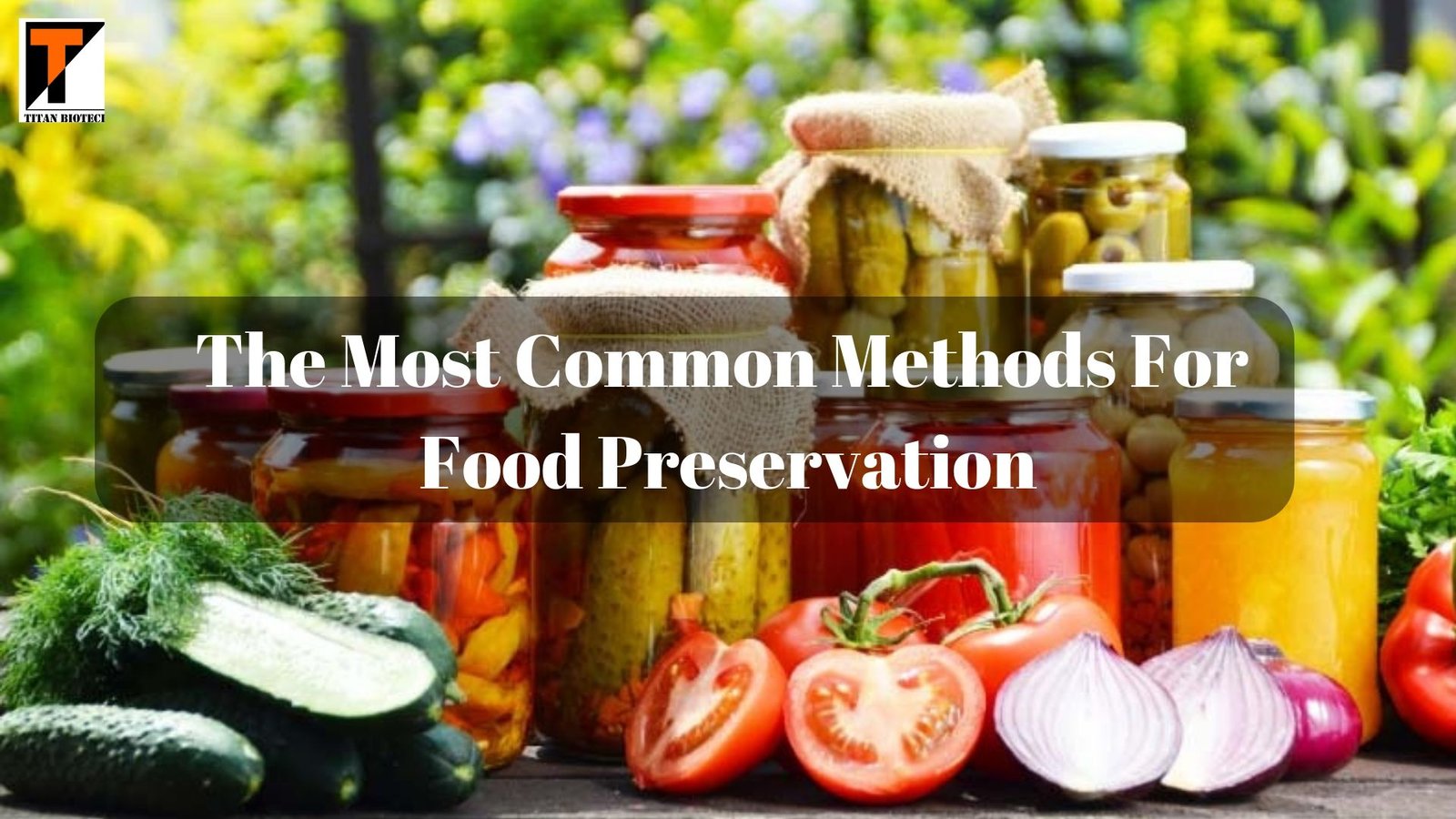Table of Content
- Use of Preservatives in the Food Industry
- Methods of Food Preservation
- Physical Food Preservatives
- Chemical Food Preservatives
- List of Natural Preservatives for Food
- Why choose Titan Biotech?
Food preservation can be a matter of life and death. No one wants to think about the possibility of food poisoning, but it does happen. The best use of preservatives to prevent foodborne illness is simply to buy fresh, clean food.
The USDA estimates that every year, from a few hundred thousand cases to more than 100 million cases, people get sick from eating contaminated foods. Most of these illnesses are caused by bacteria or parasites in undercooked meat or poultry or dairy products such as milk and cheese, but they can also be caused by an insect infestation or even a chemical reaction with the packaging material.
Use of Preservatives in the Food Industry
Preservatives are added to food to fight spoilage caused by bacteria, molds, fungi, and yeast. Preservatives are commonly used in medicines such as acetaminophen, insulin, and cough syrup to help prevent microbial contamination. In cosmetics and personal care products, preservatives help prevent contamination and the growth of harmful bacteria.
In many applications, preservatives are used to inhibit the growth of microorganisms on raw materials or finished products. When applied at levels that do not cause off-flavors or odors or discolorations, these compounds can be considered safe for use in foods and cosmetics. However, when preservatives are used in excess of their labeled concentrations, they are known to damage the quality of food products by interfering with their nutritional value or by altering their sensory characteristics.
Preservatives can also be used in cosmetics to extend the shelf life of products by helping to prevent microbial contamination. Many preservatives are colorless or clear liquids that do not change appearance when added to a product. Others may have a slight tint after use or develop a slight odor over time.
Methods of Food Preservation
1. Physical Preservation
This is a method in which we preserve the food by adding certain chemical agents to the food. It is also known as non-chemical preservation. For example, sugar and salt can be used for the physical preservation of foods. These chemicals prevent the oxidation of fats, protein, and carbohydrates in foods, making them more stable.
2. Chemical Preservation
Chemical preservation involves adding preservatives such as acidity or sugar water to foods before they go into storage containers. These ingredients are added to foods for different reasons:
- They protect against microbial growth;
- They prevent oxidation; and
- They alter the flavor and texture so that unappealing changes don’t occur during storage.
Some examples include calcium propionate which prevents rancidity in butter; potassium sorbate which prevents mold from growing on fruit juices.
Physical Food Preservatives
Some of the most common food preservatives methods are listed below:
- Chilling and freezing: Chilling and freezing are one of the best physical ways to preserve food.
- Canning: It is another way to preserve food by preventing spoilage caused by bacteria and other microorganisms that are present in the surrounding environment. After being canned in boiling water (212°F), jars are cooled quickly to prevent them from cracking or exploding during processing.
- Use high-quality ingredients to preserve food: The quality of canned products depends on what goes into them.
- Dehydrating: Another way to preserve food is by dehydrating it (i.e., drying); this process uses heat, so one needs to know how much time it takes for the food to be completely dehydrated before starting.
- Adding salt: You may also ferment foods or add salt to allow them to last longer without rotting or use sugar syrup as an addition for pickling vegetables.
Chemical Food Preservatives

Food preservatives are used to prevent the growth of microorganisms (e.g., bacteria, moulds, and yeasts) that can cause food spoilage. The most common food preservatives are antioxidants and antimicrobials (e.g., BHA, BHT).
Antioxidants prevent the oxidation of fats (lipids) in foods by preventing oxygen from reacting with them.
Antimicrobial agents stop bacterial or mold growth in food by killing microorganisms or inhibiting their growth. The most commonly used antimicrobial agents are benzoates (sodium benzoate and potassium benzoate).
-
Calcium Propionate Powder
Calcium propionate, also called calcium salt of propionic acid, is a type of acid, which is a chemical compound that has an acidic taste and odor. Calcium propionate has been used in foods for many years to prevent spoilage and keep foods from becoming discolored or losing flavor or texture.
-
Potassium Sorbate
Potassium sorbate is an antioxidant that helps prevent spoilage caused by bacteria. It is also used by the food industry as it helps prevent mould growth on fresh fruits and vegetables that have been exposed to the air. Potassium sorbate is often used by businesses in jam and jelly making as a preservative to prevent fruit from turning brown while it sits on the countertop. It’s also added to packaged baked goods like cookies, crackers, and pieces of bread to help keep them fresh longer without sacrificing flavour or texture.
The most common chemical preservative used by businesses are:
- Benzoates (like sodium benzoate)
- Nitrites (like sodium nitrite)
- Sulphites (like sulphur dioxide)

The “instant” or “quick-acting” type is often used for meats, fish and other products that need to be kept at a certain temperature for a short period of time. For example, food manufacturers use it to prevent bacterial growth on ready-to-eat sandwiches. These types of chemicals can also be used to extend the shelf life of spices, such as garlic powder and onion powder, which are sensitive to heat damage.
The “stable” type is designed to keep food fresh for several weeks or months at room temperature. They’re usually derived from natural compounds found in plants or animals that are unaffected by light or heat. The most common stable formulae are potassium sorbate, sodium benzoate, and potassium metabisulphite.
List of Natural Preservatives for Food

Natural preservatives are an effective way to preserve food. They are a natural, safe way to extend the shelf life of many foods. Natural preservatives for foods can be used in foods and drinks to help prevent spoilage and maintain freshness without artificial ingredients or chemicals.
-
Vinegar
Vinegar is one of the oldest and safest methods used to preserve foods. It’s great for pickling and canning fruits and vegetables, but it also works as a natural preservative in baked goods, condiments, and even salad dressings.
-
Cider Vinegar
Cider vinegar is made from fermented apples (obviously). It has many health benefits including lowering cholesterol levels, fighting cancer cells, and even helping you lose weight! Cider vinegar also has antibacterial properties thanks to its high acetic acid content (which is formed during fermentation).
-
Balsamic Vinegar
Balsamic vinegar, which is made by the fermentation of grapes, has been used for centuries to preserve food. It has a low acidity level and can inhibit the growth of bacteria and fungi that cause decay.
-
Black Peppercorns
Black peppercorns are the dried berries of a tree that grows in India, Africa, and Southeast Asia. They have antimicrobial properties and can be used to preserve foods by preventing spoilage or inhibiting the growth of bacteria.
-
Citric Acid
Citric acid is a natural preservative that inhibits spoilage by forming a protective coating on food surfaces which prevents them from absorbing moisture and air, thereby preventing microbial growth and food deterioration.
-
Dill Seeds
Dill seeds have been used as a preservative since ancient times; they contain an antioxidant called phenolic compounds which are antibiotic and antifungal agents that inhibit bacteria growth on food surfaces such as meats and fish by inhibiting their ability to attach to surfaces or produce colonies
- Paprika (red pepper) powder, turmeric, asafoetida (hing) powder, mixed spice (papain), annatto extract, carotenoids (provitamin A), cayenne pepper, garlic, and onion powders.
- Spices such as allspice berries, cinnamon, cloves, aniseed, black pepper berries, cumin seeds, and mustard seeds (which contain paprika).
Why choose Titan Biotech?
We, at Titan Biotech, offer the best products at the most competitive prices in the market. Our products are approved by all regulatory agencies like GMP, and ISO 13485:2003.
Our company is one of the leading Manufacturers and Suppliers of high-quality Biological Products. We offer our products at competitive prices in compliance with international quality standards.
We have been in this field for more than 30 years. Our team is committed to providing our customers with high-quality products at affordable prices.
References
- https://www.iprjb.org/journals/index.php/JAH/article/view/1067
- https://www.sciencedirect.com/science/article/pii/S0924224420306452
- https://www.banglajol.info/index.php/cerb/article/view/33809
- https://www.sciencedirect.com/science/article/pii/S2772753X2200003X

